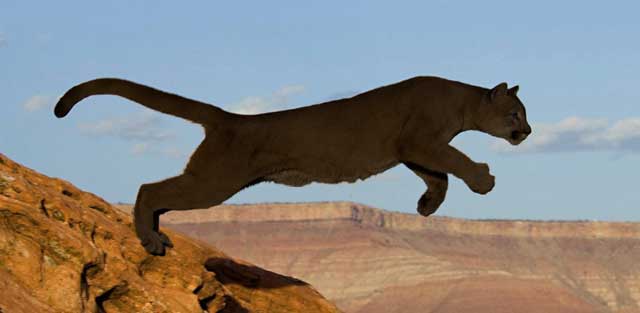Unsurprisingly, I have not been able to find a photograph of a black mountain lion so I created one (or two). They are not that great but they give an idea of what a black puma might look like; not dense black but “melanistic”.

Here is another attempt (this is better, I believe):

The mountain lion is the largest native North American cat. It is a retiring cat which rarely confronts humans. Its size is frequently overestimated. Compared with other large cats, the mountain lion has unusually long hind legs, which are probably adapted for jumping. The long, lanky appearance should be a guide to cougar sightings.
The mountain lion is a plain-colored cat. Its coat color varies from a “grizzled” gray to a dark brown with “intermittent shades of buff, tawny, and cinnamon red”. The color changes geographically.
In warmer, more humid areas, the coat color is darker. In drier places the coat is lighter.
Along the back, the coat color is more intense compared to the shoulders and sides. The chin, throat and belly area are shades of white.
Black mountain lions are called “black panthers” by some people. Technically they are called “melanistic pumas”. Melanism refers to the dominant gene mutation that leads to the creation of “melanin”, the dark brown/black pigmentation in skin and hairs.
S.P. Young refers to black panthers being shot in South America in The Puma, mysterious American cat (1946?). On this website there are a number of pages on sightings of large blacks cats. None of the sightings are verifiable.
In the past, biologist/authors have referred to black mountain lions. This is a reference to the Eastern Cougar:

In North America there have been thousands of reported sightings of black mountain lions but none have been authenticated. They are a bit like the Loch Ness Monster. Personally, I see this is as an expression of a subliminal fear of the (a) the dark and (b) the unknown and a throwback to the days when people were genuinely under threat from big cats.
There are no museum skins of black pumas (“puma” is the more scientific name for this cat). However, in the past and today, USA sightings of black pumas occur with regularity in much the same way that big cat sightings occur in the UK.
Interestingly, black panthers are the most commonly seen big cat in Florida where there are scarcely 100 mountain lions in total. Scientists say that there are no black panthers in Florida. What they say should be treated as accurate because the Florida Panther is one of the most studied wild cats on the planet with most of them carry radio collars. Many have been photographed and followed since birth.

Sarah Hartwell, the doyen of mysterious mutated big cat information, writes that a American hunter, Thomas Roosevelt, records shooting a puma that was “slatey-grey”. This is different to the black puma, in my opinion. The puma, as mentioned has a variety of colors and densities. Guggisberg, she writes, reported black mountain lions in Central and South America but not the United States or Canada. There are other reports of melanistic pumas in S. America, apparently.
Black mountain lion sightings are almost invariably black domestic cats seen at a distance in perhaps poor light. People are rather suspect at judging the size of cats at a distance when imagination plays a large role.
However, many people would argue that all the sightings can’t be wrong.


Yes, and thanks for stopping by and commenting.